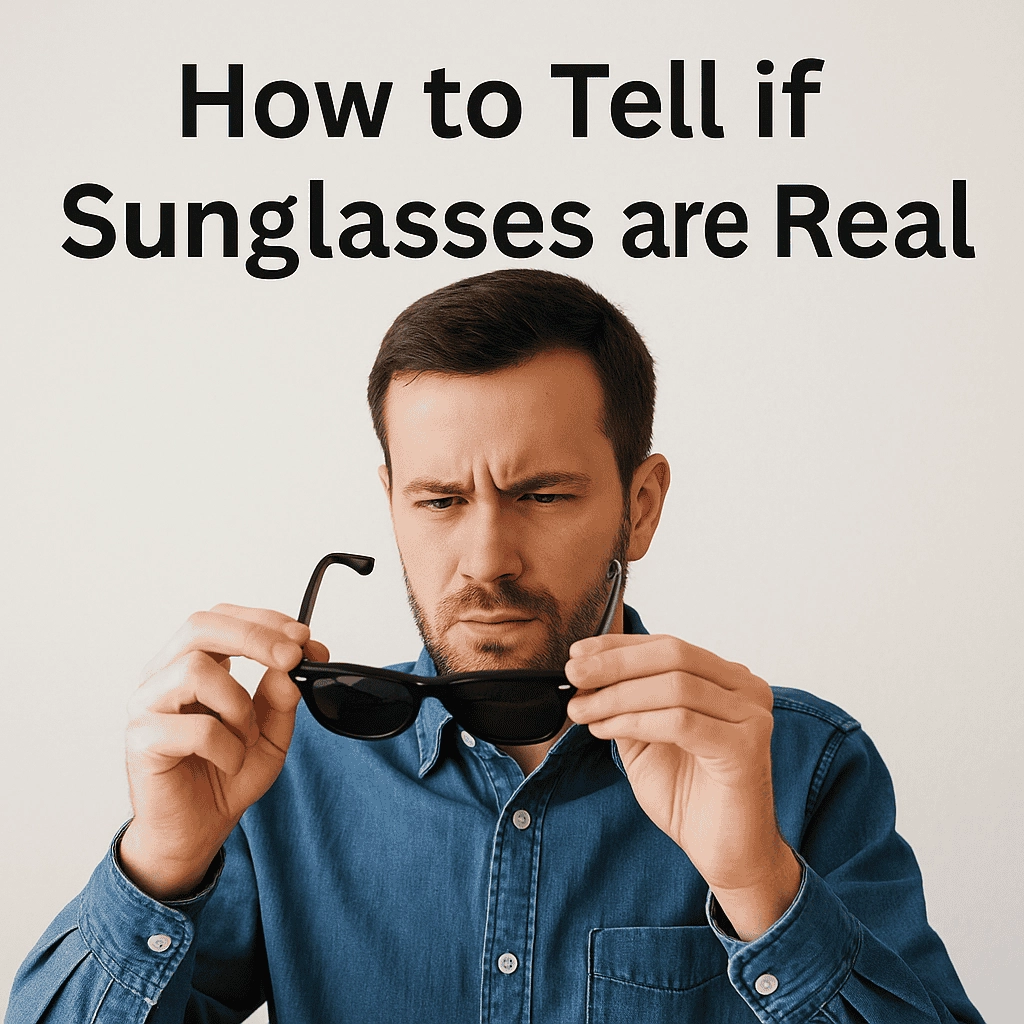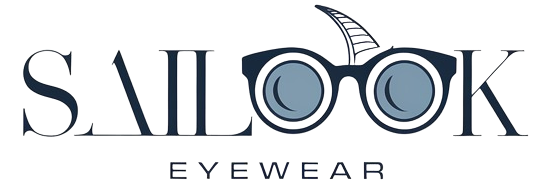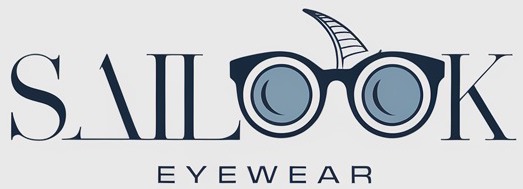You’ve got a pair of sunglasses, but something feels off. Maybe the logo doesn’t sit right, or the hinges seem flimsy. You’re not alone. Many brand owners and buyers in the eyewear industry face the growing challenge of identifying fake or low-quality sunglasses, especially in a saturated global market. But here’s the good news: this article will guide you step-by-step through every detail you need to evaluate the authenticity of sunglasses—whether it’s a prototype sample, a factory-sent frame, or a competitor’s product.

1. What are the common ways to spot authentic sunglasses?
Let’s get straight to it. Most people start with the basics—visual checks. A genuine pair of sunglasses often speaks for itself if you know what to look for.
● Brand logos are one of the most misused elements in counterfeit frames. Real logos are laser-etched, engraved, or precisely printed.
● Etching quality on hinges or inside the temples can reveal a lot. Authentic pieces have smooth, clear markings.
● Model numbers or SKU codes should match what’s found in official catalogs or brand websites.
● Material feel and overall build give away low-cost manufacturing.
Here’s where it gets interesting: counterfeiters often get close, but small inconsistencies—like font thickness or logo alignment—can expose a fake.
| Feature | Authentic Sunglasses | Fake Sunglasses |
|---|---|---|
| Logo Print | Etched or precisely printed | Off-center, smudged, or cheap stickers |
| SKU Code | Matches brand catalog | Often missing or incorrect |
| Build Quality | Balanced, sturdy | Flimsy, uneven finish |
2. How can packaging help verify authenticity?
Now, let’s dig into the box. Often overlooked, the packaging can reveal everything you need to know before even touching the sunglasses.
● Branded cases from premium brands are well-crafted, made from real leather, or premium plastics, and carry embossed logos.
● Cleaning cloths and booklets are printed on high-quality paper with no spelling mistakes.
● Barcodes, QR codes, or holographic stickers are typically found on the box or booklet and often link to the official brand site.
● Packaging consistency—the font, color scheme, and logo size should match the brand’s existing packaging.
But here’s the kicker: even when the sunglasses look convincing, cheap or generic packaging can be a major red flag.
| Packaging Element | Real Brand | Counterfeit |
|---|---|---|
| Case | Branded, premium build | Generic or wrong material |
| Booklets | Clear, consistent print | Poor translation or formatting |
| QR Code | Verifies product online | Leads nowhere or is fake |
3. What role do lens markings play in identifying a brand?
Ready for the good part? Let’s talk about lenses. Top-tier sunglasses brands embed identifiers in or on their lenses, often unnoticed by regular users.
● Laser-etched logos are subtle, usually in the corner of the lens. They’re not easy to scratch off.
● Brand initials like “RB” for Ray-Ban or “O” for Oakley can appear on lenses, but never as stickers.
● Polarized lens indicators are often etched, not printed.
● Authenticity watermarks under light exposure or magnification reveal fine detailing.
You might be wondering: why does this matter? Because fakes often rely on stickers that peel off or fade quickly, unlike permanent lens marks.
| Lens Identifier | Real Product | Fake Product |
|---|---|---|
| Logo | Laser-etched | Sticker or printed surface |
| Polarized Label | Engraved in corner | Printed on outer surface |
| Clarity | Consistent | Blurry or uneven finish |
4. Are there differences in weight and feel between fake and real sunglasses?
You pick them up—and suddenly, it’s obvious. The way the frame feels in your hand or on your face can be a dead giveaway.
● Authentic frames are weight-balanced, thanks to materials like acetate, titanium, or stainless steel.
● Fake sunglasses feel lighter or uneven, especially in the temples.
● Creaking sounds when opening the temples or hinges is another warning sign.
● Grip and tension are smooth in real sunglasses but feel loose or too tight in counterfeits.
Here’s what surprises most people: while lightweight can feel “premium,” too light might actually signal cheaper plastic or poor assembly.
| Aspect | Authentic | Counterfeit |
|---|---|---|
| Weight | Balanced and natural | Too light or uneven |
| Joint Movement | Smooth and resistant | Loose or sticky |
| Feel | Solid, cold to touch | Plastic-like or warm |
5. Can the hinges and screws give away counterfeit sunglasses?
Let’s zoom into the small stuff. Hinges and screws are often ignored but hold some of the most telling clues.
● Real hinges are spring-loaded or reinforced, giving a smooth, click-in-place feeling.
● Screws should be centered, flat, and flush with the frame surface—never crooked.
● Hinge screws in quality sunglasses don’t loosen easily.
● Excess glue or gap lines near hinges often reveal rushed, subpar production.
What’s the real story? Premium brands invest in durability—fakes don’t. Even if they look similar, the hardware tells another story.
| Component | Authentic Frames | Fakes |
|---|---|---|
| Hinge Style | Spring or reinforced | Fixed, poor motion |
| Screw Position | Flush, well-centered | Misaligned, rough edges |
| Finish | Clean, tight joints | Glue stains, loose gaps |
6. How do brand-specific identifiers help in recognizing genuine sunglasses?
Time to get specific. Each eyewear brand has its own signature quirks—think of them like fingerprints.
● Ray-Ban prints the logo on both the lens and temple, often with a model number like “RB2132.”
● Oakley uses “O” icons, rubber grips, and style-specific serial numbers.
● Gucci or Prada place serials on the inner arms and use luxury-tier cases.
● Maui Jim includes polarized verification cards in the packaging.
Don’t overlook this: if the sunglasses you’re holding don’t follow the brand’s known design format, they’re likely not authentic.
| Brand | Key Identifier | Location |
|---|---|---|
| Ray-Ban | “RB” laser etch | Lens and temple |
| Oakley | “O” logo + style number | Nose bridge, arms |
| Gucci | Serial code | Inside temple arm |
7. Is price a reliable indicator of authenticity?
Let’s talk numbers. Price can be a huge red flag—but only when used in context.
● Genuine designer sunglasses typically fall within a price range—for example, $150–$300.
● Prices that seem “too good” to be true—say, $40 for a “Gucci” frame—almost always are.
● Discounted authentic items exist but usually come from licensed retailers.
● Bulk deals on marketplaces like AliExpress, DHGate, or unknown Instagram shops often signal counterfeit stock.
So here’s the bottom line: price is a clue, not a guarantee.
| Price Range | Real | Fake |
|---|---|---|
| $10–$40 | Unlikely | Very Likely |
| $100–$300 | Normal for premium brands | Rare for fakes |
| $300+ | High-end designer frames | Often falsely inflated |
8. What is the risk of buying from unofficial platforms?
Not all platforms are created equal. Where you buy matters as much as what you buy.
● Unverified platforms may ship poor imitations without returns or guarantees.
● Social media shops often rebrand generic frames as “designer inspired.”
● No traceability—fake sellers frequently disappear after a transaction.
● Missing warranty or service is another clue—it’s rarely offered with fakes.
But here’s the kicker: these platforms often use stolen photos from legitimate brands to create a false sense of security.
| Platform | Risk Level | Red Flags |
|---|---|---|
| Brand’s Official Website | Low | None |
| Third-Party Marketplaces | Medium–High | No seller info, generic photos |
| Social Media Stores | High | No returns, no reviews |
9. How does the seller’s reputation affect trustworthiness?
Reputation matters. Before purchasing, it’s worth spending five minutes checking who you’re buying from.
● Authorized retailers are listed on most brand websites—always double-check.
● Reviews and testimonials can indicate past buyer satisfaction or frequent complaints.
● Professional presentation—clear product descriptions, photos, and contact information—is a strong signal.
● Shady sellers often use stock photos and refuse to provide real-time product images.
And here’s where it gets critical: a poor reputation often correlates with a high risk of counterfeit or misrepresented goods.
| Seller Type | Trust Level | Checkpoints |
|---|---|---|
| Brand-verified retailer | High | Listed on brand site, reviews |
| Unknown e-commerce | Medium | Needs review check |
| Social seller / DM order | Low | Risky, lacks transparency |
10. Can you identify fakes just by wearing the sunglasses?
Let’s go hands-on. Wearing the sunglasses often reveals more than just looking at them.
● Lens clarity is a huge factor. Real sunglasses filter light consistently, without distortion.
● Comfort and fit should feel snug but not tight, with balanced weight distribution.
● Eye strain or headaches after 15–30 minutes may indicate poor UV protection.
● Temple pressure or ear discomfort are signs of bad mold alignment.
Ready for the twist? Cheap lenses may even harm your eyesight over time. Spotting fakes by feel protects both your business and your customer.
| Wear Test | Genuine | Fake |
|---|---|---|
| Visual Clarity | Clean, undistorted | Blurry or tinted |
| Fit | Balanced, secure | Uneven or uncomfortable |
| UV Protection | Certified & safe | Often missing or fake claims |
11. What are the best places to buy authentic sunglasses?
Don’t just shop—shop smart. Knowing where to buy cuts your risk significantly.
● Official brand websites remain the safest bet for buying real sunglasses.
● Major optical retail chains often carry certified inventory and offer after-sales support.
● Authorized B2B distributors can provide bulk pricing with authentic verification.
● Eyewear expos or trade fairs offer in-person verification and product sampling.
So here’s the strategy: combine visual checks, seller reputation, and buying from the right place to eliminate most fake risks.
| Store Type | Verification | Extras |
|---|---|---|
| Brand Website | 100% verified | Warranty included |
| Chain Retail | Vetted inventory | Fitting & returns |
| B2B Distributors | Documented sourcing | MOQs, invoicing |
12. How do serial numbers help in identifying sunglasses?
Let’s decode this. Serial numbers aren’t just random—they’re trackable fingerprints.
● Location of serials varies by brand, often on the temple or inside arm.
● Online verification tools from luxury brands allow you to confirm codes.
● Fake codes often copy generic patterns or use nonexistent identifiers.
● Cross-checking the model on official brand catalogs helps confirm legitimacy.
Here’s a key insight: serial number mismatches between frame and case packaging are a big warning sign.
| Serial Indicator | Real Frame | Counterfeit |
|---|---|---|
| Code Format | Brand-specific, consistent | Random or misspelled |
| Online Match | Matches product | No listing found |
| Placement | Etched or printed inside | Missing or wrong spot |
13. How can apps or websites help verify sunglasses?
Technology can lend a hand. Today, digital tools can verify your product in seconds.
● Brand QR scanners let you scan barcodes directly from packaging.
● Authentication apps like Legit Check or CheckFresh offer photo verification.
● Brand support centers may confirm authenticity if you send frame photos.
● Third-party review tools like Trustpilot highlight which sellers are safe bets.
But here’s the kicker: tech tools are useful, but they aren’t foolproof—especially if fakes copy real serials or codes.
| Tool | Purpose | Limitation |
|---|---|---|
| QR Code Scans | Verify serials | Needs connection to brand database |
| Photo Apps | Spot visual fakes | Limited brand coverage |
| Online Reviews | Seller validation | Can be faked too |
14. What should you do if you suspect your sunglasses are fake?
Caught something off? Take action. Don’t let a suspicious pair sit on the shelf.
● Compare the frame with official brand listings—model number, material, and logo position.
● Contact the brand for confirmation or submit a claim if you bought through an authorized channel.
● Avoid selling or distributing anything you can’t confirm. This protects your business and avoids legal risks.
● Notify your supplier and reconsider future transactions if they knowingly sent fakes.
What’s the bottom line? Catching a fake early protects your business from returns, customer complaints, and damaged reputation.
| Action | Purpose | Benefit |
|---|---|---|
| Verification | Confirm suspicion | Clarity for resale or return |
| Brand Contact | Official check | Peace of mind |
| Stop Resale | Prevent issues | Legal & ethical safety |
15. How can you protect yourself from future counterfeit purchases?
Let’s wrap this up with smart habits. Prevention is always cheaper than damage control.
● Create a standard checklist for every frame you purchase or source.
● Build long-term relationships with verified manufacturers or B2B partners.
● Request documentation—certificates, serial lists, and packaging mockups.
● Audit your supply chain regularly to reduce risk from upstream fraud.
And here’s your final takeaway: staying alert, educated, and selective is the best long-term strategy for any eyewear business.
| Protective Action | Frequency | Impact |
|---|---|---|
| Checklist Use | Every order | High confidence |
| Supplier Vetting | Quarterly | Risk reduction |
| Verification Requests | Per batch | Build trust |
Conclusion
Staying sharp about sunglasses authenticity isn’t just a matter of pride—it’s business survival. Whether you’re sourcing bulk for a brand or curating a retail selection, knowing what makes a pair genuine protects your reputation and customer satisfaction. Use the checklist, understand the warning signs, and don’t cut corners when it comes to supplier selection. It’s your brand, your risk—and your competitive edge if done right.
FAQ
Q1: What is the easiest way to spot fake sunglasses?
A clear giveaway is poor logo placement, flimsy build, and low-quality packaging that doesn’t match brand standards.
Q2: How does brand packaging help confirm authenticity?
Official packaging includes branded cases, cleaning cloths, barcodes, and often an authenticity card or booklet.
Q3: Do all real sunglasses have serial numbers?
Not all, but many premium brands include serial numbers or model codes either etched or printed discreetly.
Q4: Can you return fake sunglasses bought online?
It depends on the seller and platform policies. Many unofficial sellers won’t accept returns or disappear after purchase.
Q5: Are expensive sunglasses always real?
No. Price alone doesn’t guarantee authenticity. Some counterfeits are sold at near-retail prices to appear legitimate.

